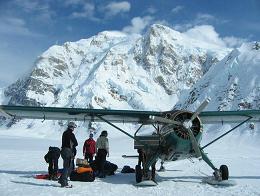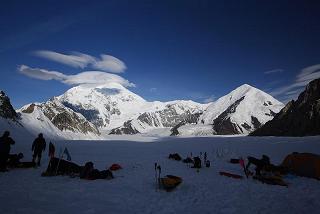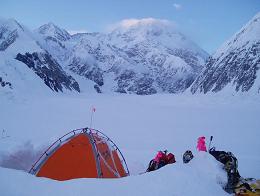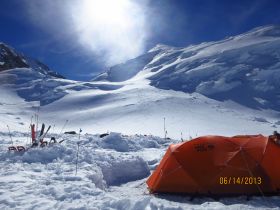
|
Expedition Chronology II. Lower Mountain |

|
Then there is dinner. Conditions are mild enough that a tent specifically for cooking and eating is not constructed. Instead food is prepared and consumed outdoors in a roughly circular pit fashioned out of the local material of choice - snow. Tonight we have pasta primavera with chicken.
I tent with Nick Klaich on my left and Jean François to the right.

|
| Deplaning at Kahiltna Base Camp. |
Next morning Nick surprises us in deciding to not continue, citing unfamilarity with snow camping and a low vestibule entrance that's difficult to manage with his tall frame. He packs for a flight off the glacier.
Immediately I realize that a weight savings is now possible since a tent for two people is lighter than one designed for three individuals. We will swap tents with an outgoing group - and the haste of packing my tentbound stuff and erecting a new tent (to test the concept) is a frantic one that I never signed-on for.
I hate rushing. I hate deadlines without the opportunity to proceed at a normal pace. Any peace of mind is lost, maddeningly replaced by an all-embracing sense of urgency. People should plan their days so that they never have to rush. Sadly, in America it's the norm, and verified every time I drive on the highway at exactly the 70 miles per hour speed limit, only to see the vast majority of motorists pass me by - sometimes even giving me "the finger" because I refuse to break the law.
Jean François and I are in the new, smaller tent, saving some pound or two in weight - a significant amount given that we are talking about several thousand vertical feet.
Next morning the standard cry goes out,
"Hot drinks in ten minutes!"
signaling that everybody should meet in the kitchen tent (the "mid") for using hot water to prepare beverages - followed immediately by a hot breakfast. It's an important announcement because one might be putting on boots or performing some more prolonged activity that cannot be reasonably interrupted. The advance warning is then quite essential. Water bottles are also filled, everybody having generally a two liter capacity.

|
|
Base Camp in morning, view west to Mount Foraker with lenticular cloud. |
I arise fully 30 minutes before others so that I can perform tentbound chores without feeling rushed. This includes taking vitamin pills (to mitigate the lack of fresh fruits and vegetables) and lysine (to thwart growth of the Herpes Labialis virus which causes lip sores); emplacement of climbing harness because my fingers might be too cold later on; and of course dressing according to the temperature and planned activity.
I suspect that others have analogous rituals such as placing contact lenses and taking medication for known conditions.

|
kills review for glacier travel is today's classroom. The day is quite "warm", especially inside the tent whenever the sun shines without cloud cover. One never goes outdoors without glacier glasses under such conditions - the snow is absolutely brilliant and would likely yield snow blindness in a timespan shorter than needed to realize something is amiss.
Dinner includes a pair of steak and cheese sandwiches on French rolls for each person. They are simply terrific, and designed for large calorie content more than anything else. I always have "seconds" when it is available, the aim being to not lose weight and hence diminish overall energy level. Generally seconds are available - and I am always appreciative. I cannot afford to lose weight here as I have virtually no body fat to begin with.

|
|
View south down the Kahiltna Glacier. Note the separation of climbers with their sleds. |
Climbing Mount McKinley burns an immense number of calories - it would be a most effective way to diet were somebody so inclined. But not today. I am too skinny and have always been that way with a ridiculously high metabolism that most (females) would kill for.
We turn-in early so as to arise at the unlikely hour of midnight. Of course it's impossible sleeping in broad daylight at 6 p.m. when one normally retires six hours later. So I just lie down and try to think of nothing - and fail as always. Math problems then occupy my time...

|
he chosen hour of departure, 2 a.m., is overshot by 40 minutes as we are not (yet) efficient at the large number of tasks forming a camp move on the glacier. Still, it's the night's coldest time because from 1 to 3 a.m. the sun is indeed below the northern horizon. That's exactly the point - traveling while snowbridges are firm so as to minimize the chance of a crevasse fall.
On the lower route, crevasses are a fact of life. The key is avoidance altogether - and especially as considerable time and energy is needed to extract a fallen climber.
It is five miles to the base of Ski Hill at 7,800 feet elevation. First we descend Heartbreak Hill, our sled's brake, a loop of rope, in the down position to create friction. A sled is definitely not your friend! It will do everything possible to ruin your day. However it's a necessary evil on the lower route because it allows one to transport more weight than is feasible simply on one's back - and at Mount McKinley there is a lot of stuff.
Both Heartbreak and Ski Hills are not really hills as they have zero prominence. They are merely locations on the climbing route with a change in slope.

|
| Ski Hill camp with Mount McKinley. |
Mount Foraker's uppermost reaches now glow a faint pink as the sun, completely hidden from our view, manages to cast light ten thousand feet above us. For all we know it might not have even risen above our theoretical horizon: for I have calculated that elevation transforms a 2 1/2 hour period of twilight into actual daylight while climbing the West Buttress route's entire vertical expanse. This effect is remarkable, and only occurs because we are near the summer solstice and very close to the Arctic Circle. In effect, the altitude allows one's northern horizon to approach the Arctic Circle.
Indeed, I project that, after account of atmospheric refraction, there should be a sliver of midnight sun at Mount McKinley's summit (and only there) from June 17 through 27. Perhaps some day a reader will verify my claim.
Travel as a rope team demands constant vigilance - just like driving an automobile. However it does not require huge concentration or mental acuity. The rope should never slacken as that compromises its entire purpose - stopping a crevasse fall. Your pace exactly matches the climber immediately in front. Thus the entire rope team moves at the rope leader's rate. Particular attention is paid when a climber crosses an obvious weakness in the snow.
Once in a while I'd daydream, only to find, 5 seconds later, being reprimanded by Caitlin for having let rope build near her snowshoes: for some reason I'd speed during such thoughtless moments. (This also means I am capable of carrying more and/or going faster). It's a shame because one cannot enjoy the scenery for more than brief glances left and right. I can truly comprehend the magnificent scenery only during our hourly rest stops for food and drink.

|
| Kitchen tent at Ski Hill camp. (MT photo) |
We reach Camp I in some 4 to 5 hours. Climbers are belayed into camp because it has yet to be fully probed for crevasse hazard. Later our activities are strictly delimited by wands marking a safe camp perimeter.
We now erect tents, filling them with our goods. The plan calls for rest and food until the next period of relative chill. Meanwhile the guides get little rest. They are already busy, uphill on skis, emplacing a food cache with group meals.
Even at Ski Hill camp the vista down-glacier is magnificent. It is over one mile wide here, and such distances deceive because the nearby peaks, most seemingly unclimbable, appear much closer.

|
he next pair of days see as many camp moves. The clients get to single-carry in light of the guide's hard physical labor. It's a significant advantage not having to "climb the mountain twice". First we move camp to 9,600 feet, having arisen at 2 a.m. rather than midnight - while taking 2 hours 10 minutes to break down camp (an improvement).
A gust of wind has my woolen hat flying:
- I call a halt to our movement.
The hat literally blows off my head without any warning. One of the guides sees this as a personal failing on my part - which is absurd. It just "happened". Am I supposed to attach it with a clothes pin or something? Sheesh. Fortunately Yoshiko, on a separate rope lower down the slope, manages to snag the errant object - returning it in camp.
- We resume.

|
|
Looking downhill at Squirrel Hill. Climbers in the distance have just ascended Motorcycle Hill. (Mouse-click image to view.) |
The next morning we arise at 4 a.m. and reach the top of Kahiltna Glacier, at Kahiltna Pass some 10,000 feet above sea level. Then we head sharply right (east) to a camp at 11,000 feet as measured by GPS unit (the "official" elevation is 11,200 feet). This camp will serve as home for fully three nights as henceforth the clients will now double-carry.
The guides have been working hard. They need a rest day, a fact that speaks volumes for level of effort and dedication to their task.
At this elevation and above the snow is sufficiently hard that snowshoes are of marginal utility. Hence we now switch from sleds, snowshoes and trekking poles to crampons and ice axes. I am pleased to no longer deal with the complications of a sled - that is, until our descent.

|
night-based schedule is maintained as it's easier traveling on firm surfaces rather than mush. After several hours, we emplace a cache just beyond Windy Corner (13,000 feet) at the 13,350 foot level - and then return to camp, consuming only one-third the time for descending.

|
| 11,000 foot Camp II (MT photo) |
The route alternates between moderately-angled slopes and essentially flat terrain. The former includes Motorcycle Hill (camp to 11,800 feet), Squirrel Hill (to 12,300 or 12,400 feet), just below Windy Corner (12,600 to 13,000 feet) and just beyond it (to 13,200 feet).
Motorcycle and Squirrel Hills have zero prominence.
Then the big move to Advance Base Camp (14,300 feet) is made. It consumes about 6 hours, and we arrive at this minor village around 10 in the morning. I am quite pleased to be here: for even if the weather turns on us we can still use the time for beneficial acclimatization.
The next morning, an "active rest day", we retrieve the cache after a half hour descent followed by a one hour reascent to camp.
Meals remain the highlight of my days - everything from cheesy hash browns with bacon at breakfast (as with many dishes, a cardiologist's nightmare!) to enchiladas and pizza. There is an emphasis on cheese, which I adore, and presumably because it's a most tasty means of securing calories. Unfortunately an Asian or vegetarian client would have difficulty with the menu.
I have intentionally not specified dates in this review - civilized society's clocks have little meaning here. Only the sun's cycle matters, determining when it is best to travel and best to stay put.

|
| Mount Hunter from Ski Hill camp on the Kahiltna Glacier. (MT photo) |
| previous page - Preparations | next page - Advance Base Camp |